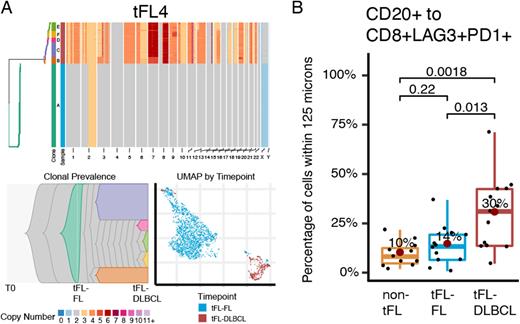Abstract
Introduction: The transformation of follicular lymphoma (FL) is believed to follow a divergent evolutionary model. However, the relationship between clonal (genetic) evolution and phenotype has been largely unexplored. Similarly, it is unknown if transformation arises from the expansion of a pre-existing clone with a transformed genotype, or if instead it requires the acquisition of genetic and phenotypic traits absent at diagnosis. In addition, previous bulk sequencing studies have provided only limited information about tumor microenvironment (TME) components. To address these shortcomings, we used single cell whole transcriptome (scWTS) and whole genome sequencing (scWGS) to characterize the clonal and phenotypic evolution of malignant B cells during transformation and elucidate interactions within TME.
Methods: Our study included 11 transformed FL (tFL) patients with paired FL and DLBCL time point biopsies, and 11 indolent FL controls (>6y follow-up without progression/transformation). Combined scWTS and BCR sequencing was performed for all samples, along with scWGS for transformation pairs. We included two independent validation cohorts of pre-treatment FLs (N=125 treated with Rituximab-Bendamustine and N=154 with Rituximab-CVP (N=154)).
Results: Phylogenetic analysis using scWGS showed a non-uniform pattern of evolution across the tFL pairs. In 3 pairs, all genetically-defined clones were composed of cells from both FL and DLBCL time points (called mixed-clones). Conversely, in 5 pairs fully divergent evolution was observed, featuring unique genetic clones at the DLBCL timepoint. Finally, 3 pairs had both mixed and unique DLBCL clones. Clustering of malignant B cells from tFL pairs using scWTS data indicated that the transcriptional similarity between the FL and DLBCL samples was inversely correlated with the time between sampling. Importantly, in the 6 pairs with well-separated FL and DLBCL clusters, some FL cells could always be found within the DLBCL clusters (so-called "DLBCL-like cells") and vice-versa. Integrative analysis of scWGS and scWTS data highlighted that samples with the fewest genomic changes showed the least transcriptional change. However, this correlation did not hold true for all tFL pairs. In particular, 2 pairs showed minimal genomic change but a high degree of phenotypic change, suggesting other determinants of cellular phenotype. Furthermore, in the 5 pairs with an extreme genomic clonal divergence, the strict co-evolution of malignant B-cell genotypes and phenotypes could not account for the presence of cells with a "DLBCL-like" phenotype in FL time point biopsies (Figure A). Differential expression and GSEA of malignant cells identified "MYC targets V1'', "mTORC1", and "OXPHOS" as pathways enriched in malignant B cells at the transformed time point compared to the earlier FL. Within these pathways, control non-tFL cells had significantly lower gene expression scores than pre-transformed FL, independent of cell-cycle state. At the TME level, a significant composition shift was observed from T cells with a TFH and central memory phenotype in FL samples, to cells with an exhausted phenotype at the time of transformation. The largest shift was an increase in the CD8+/LAG3+/PD1+ population (more than doubled, Figure B), confirmed by multicolour-IHC analysis. The magnitude of the TME shift was correlated with the magnitude of the malignant B-cell phenotypic evolution. A cell-cell interaction analysis highlighted MIF/CD44 and CD27/CD70 pathways as enriched at the time of transformation, while IL15/IL15RA signaling was more prominent in FLs. Finally, in two independent cohorts of pre-treatment FL, the proportion of CD8+/LAG3+ cells within the CD20-negative TME compartment was associated with time to transformation, time to progression and disease specific survival, independently of FLIPI score and FL histologic grade.
Conclusion: By applying high-dimensional scWTS and scWGS techniques, we describe the range of possible relationships between cellular genotype and phenotype during FL transformation. We observed different modes of clonal evolution, from the expansion of a precursor cell population present at the time of diagnosis, to the emergence of novel clones present only at transformation. Shifts in the TME composition allowed us to identify a CD8+/LAG3+ population that could be used as a predictive marker of transformation risk.
Disclosures
Scott:NanoString: Patents & Royalties; Janssen: Consultancy, Research Funding; Roche: Research Funding; AstraZeneca: Consultancy, Honoraria; Incyte: Consultancy; Abbvie: Consultancy. Craig:Bayer: Consultancy; BeiGene: Honoraria. Steidl:Abbvie: Consultancy; Bayer: Consultancy; Bristol Myers Squibb: Consultancy; Curis Inc: Consultancy; Epizyme: Research Funding; Roche: Consultancy; Seattle Genetics: Consultancy; Trillium Therapeutics: Research Funding.
Author notes
Asterisk with author names denotes non-ASH members.


This feature is available to Subscribers Only
Sign In or Create an Account Close Modal